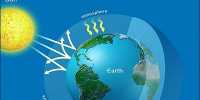Even with a passing interest in the global environment, anyone knows that all is not well. But how bad is the situation? Our new paper shows that attitudes about life on Earth are more deadly than commonly understood.
The study, published today, reviews more than 150 studies to produce an exclusive summary of the states of the natural world. We have outlined potential future trends for biodiversity loss, mass extinction, climate disruption, and planetary toxicity. We clarify the gravity of human suffering and provide a timely snapshot of the crises that need to be addressed now.
The problems associated with human consumption and population growth will almost certainly worsen in the coming decades. The damage will be felt for centuries and threatens the survival of all species, including our own.
Our paper was written by 17 leading scientists from the University of Flinders, Stanford University, and the University of California, Los Angeles. Our message may not be popular and is really scary. But if humanity is to understand the enormity of the challenges we face, scientists must be perfect and accurate.
The problem is gripping: We first reviewed how experts can perceive the extent of the threat to its life forms, including biology and humanities. Worryingly, the study shows that future environmental conditions will be far more dangerous than experts believe.
This is mainly because educators tend to specialize in one branch which means they are unfamiliar in many cases with complex systems where planet-scale problems – and their possible solutions exist. After all, by rejecting or ignoring scientific advice, governments can thwart positive change by ignoring the behavior of both technologists and policymakers. More broadly, people’s optimistic biases – thinking bad things are more likely to fall on top of others than themselves means that many don’t underestimate the environmental crisis.
Numbers don’t lie: Our research also reviews the current state of the global environment. Although the problems are too much to cover here, they include: In less than 200 years the reefs have accounted for half of the live coral cover and a decline of 10% per decade over the last century. About 40% of the kelp forest has been greatly reduced, and the number of large predatory fish was less than 30% a century ago.
About one million plant and animal species are threatened with global extinction. The combined mass of wild mammals today is less than one-fourth that of the planet before colonization began. Insects are also rapidly disappearing in many areas Plants have been half of organic matter since the agrarian revolution began about 11,000 years ago. Overall, humans have changed about two-thirds of the Earth’s landmass.
About 1,300 recorded species have become extinct in the last 500 years, many more remain unmarked. More broadly, population-sized species have declined by more than two-thirds in the last 50 years, indicating further extinction. Eighty-five percent of global wetlands have been lost in 300 years, and more than 65% of oceans have been compromised.
A bad situation only getting worse: The human population has reached 7.8 billion – double that of 1970 – and by 2050 it will reach about 10 billion. The high population density exacerbates the epidemic. They also drive overcrowding, unemployment, housing shortages and infrastructural degradation and can pose a risk to conflict, terrorism, and war.
Basically, people have created an environmental register scheme. Increasingly, the rate of self-regeneration as a percentage of world powers has increased from 73% in 1960 to more than 170% today. High-consuming countries like Australia, Canada and America use multiple units of fossil fuels to produce one energy unit of food. In particular, the use of energy will increase in the near future as a result of the growth of the global middle class.
Then there is climate change. Humanity has already surpassed 1°C in this century, and will almost certainly surpass 1.5 °C between 2030 and 2052. Even if all countries ratify their commitments in the Paris Agreement, the warming will reach between 2.6°C and 3.1°C by 2100.














